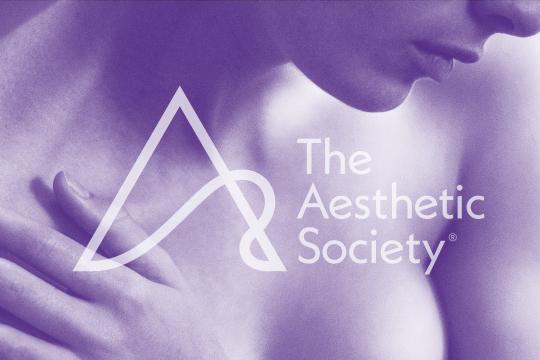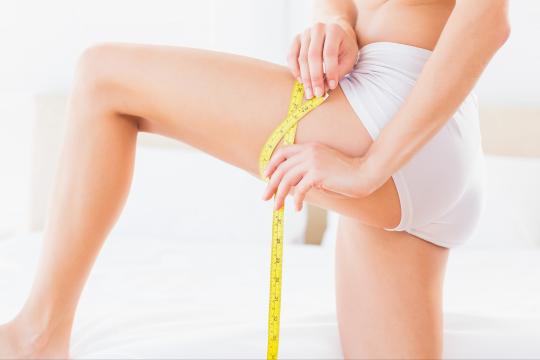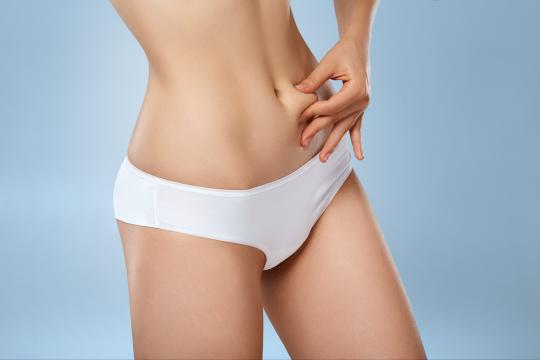Most of us would undoubtedly be the proud owners of a chiseled 6-pack if it weren’t for all the effort that it takes to get one. If you’ve ever struggled with diet and exercise to attain the aforementioned Adonis abs, or even considered liposuction or other body sculpting procedures to rid yourself of stubborn belly fat, you might be interested in a study that’s been heating up the news circuit on a procedure called abdominal etching.
Published in the medical journal Plastic and Reconstructive Surgery, this study is a comprehensive look at abdominal etching (aka. 6-pack liposculpture) through the use of power-assisted liposuction and the case studies of 50 men and women patients who are now enjoying their chiseled-out-of-stone ab results. Think surgical ab sculpting via a specific liposuction technique— no gym required. (Sort of… we'll unpack that later.) But first, what is abdominal etching?
What is abdominal etching?
Abdominal etching is a procedure in which your surgeon uses power-assisted liposuction along the lines of your own muscles to sculpt the “ideal” abs. As if that weren’t enough to peak your interest, today’s plastic surgeons can also personalize the procedure to produce results that are near-to-exactly what the patient might desire—a smoother, softer set of abs or a full-on Zach Ephron (sculpted in stone and ultra-defined—Google it). It seems that all abs are not made alike, especially those you got with the help of your board-certified plastic surgeon.
In this procedure, very specific areas of fat are suctioned from your abdomen’s superficial and deep layers in order to accentuate the patients natural abdominal lines—a “six pack” for males and 3 vertical lines in the ladies, typically with the inclusion of hip-lines for everyone. (Huzzah!)
You might remember that we’ve touted the benefits of using power-assisted liposuction with other surgical procedures before—particularly with its successful use in mammoplasty So let’s give it even more accolades here. With this type of liposuction your surgeon uses a special, smaller, vibrating cannula to suck the fat out of the offending area. The vibration helps loosen the fat before removal, which in turn makes the suctioning easier, less prone to bruising, and more precise. And precision is exactly what you want when it comes to abdominal etching.
Who’s a good candidate?
Remember when we said—“no gym required,” “sort of,” and “we’d get to it later”? Well, here we are—dispelling any illusion that abdominal etching is the “easy” way to a washboard stomach. The PRS study emphasizes the fact that each of the 50 male and female participants were already in pretty darned good shape, with healthy eating and exercise habits. Each patient chose to undergo an abdominal etching procedure because they carried a bit of stubborn tummy pooch that refused to budge, despite consistent diet or exercise efforts. If that sounds like you, you may be a good candidate.
It’s also vital to disclose to your surgeon whether or not you’ve had any liposuction in the abdominal areas in the past. Having had previous liposuction procedures may knock you out the good candidate category for abdominal etching as previous procedures can compromise a patients recovery. And if you’re thinking you’re the exception to this rule—you’re not. Disclose everything to your surgeon. That's the end of that.
Since the best candidates are used to lots of exercise consistency already, the fact that a newly chiseled washboard will require upkeep won’t come as a total shock to the system. The study claims that by offering its participants nutritional and personal training teams, the patients were able to maintain long term results (in the case of the study, six years+).
Recovery.
Recovery is no joke either. Like all plastic surgeries, a successful post-surgical result requires that you adhere to all of your surgeon’s after-care instructions. You thought your personal trainer? Wait 'til you meet your doctor (We kid. We kid.) For the first three days, you’ll be directed to wear specialized foam dressings, cut to size and worn along the newly etched lines. After that? Well… more compression—you’ll be required to wear a compression garment or dressing full-time for the first two-weeks post surgery and part-time for the two weeks after that. Follow-up is key for assessing and treating any seromas (fluid collection). While seromas are generally regarded as a minor complication, they need to be treated aggressively, so if you’re thinking about shirking off any follow-up appointments., think again. And if you’re still thinking about it after that, you’re likely not a good candidate for the procedure.
You’ll need to lay off all exercise for the first two weeks and gradually ramp your way up from light (meaning nothing that engages the core) to more rigorous exercise after about four weeks. Don't worry, there will be plenty of time to show off your new 6-pack to your gym buddies.
And now let’s talk about the other ‘R’ word.
Risks.
Like all surgical procedures, there are risks. Infection, nerve and muscle damage all live under this heading, and while they might be rare, they do exist. And since we’re already talking about minor complications… let’s talk about another one: over-etching. Over-what? Yes. Over-etching is exactly what it sounds like, a contour irregularity that resembles more stone sculpture that sculpted skin. Thankfully this complication typically soften’s up and improves with time. Your surgeon will be able to tell you more and come up with a treatment plan should this occur.
So there you have it. Yes, spot-training at the gym to get achieve a 6-pack is a myth, but spot-“training” at your plastic surgeon’s office seems to be entirely possible. A visit with your board-certified plastic surgeon is the best way to assess whether abdominal etching is right for you.







